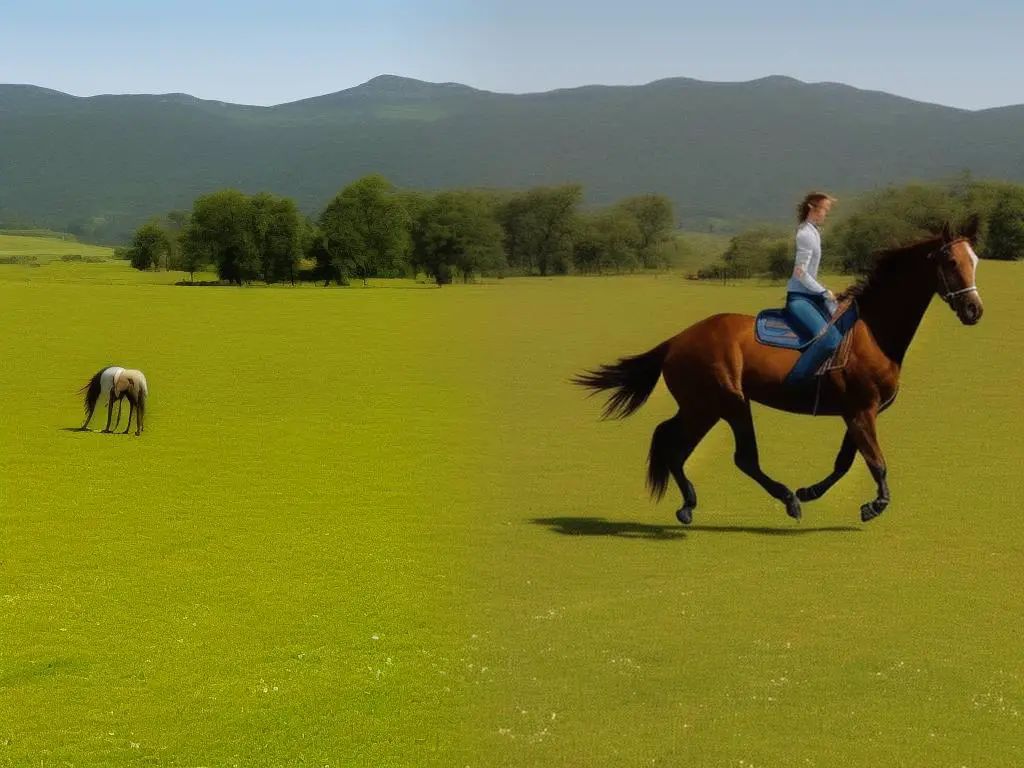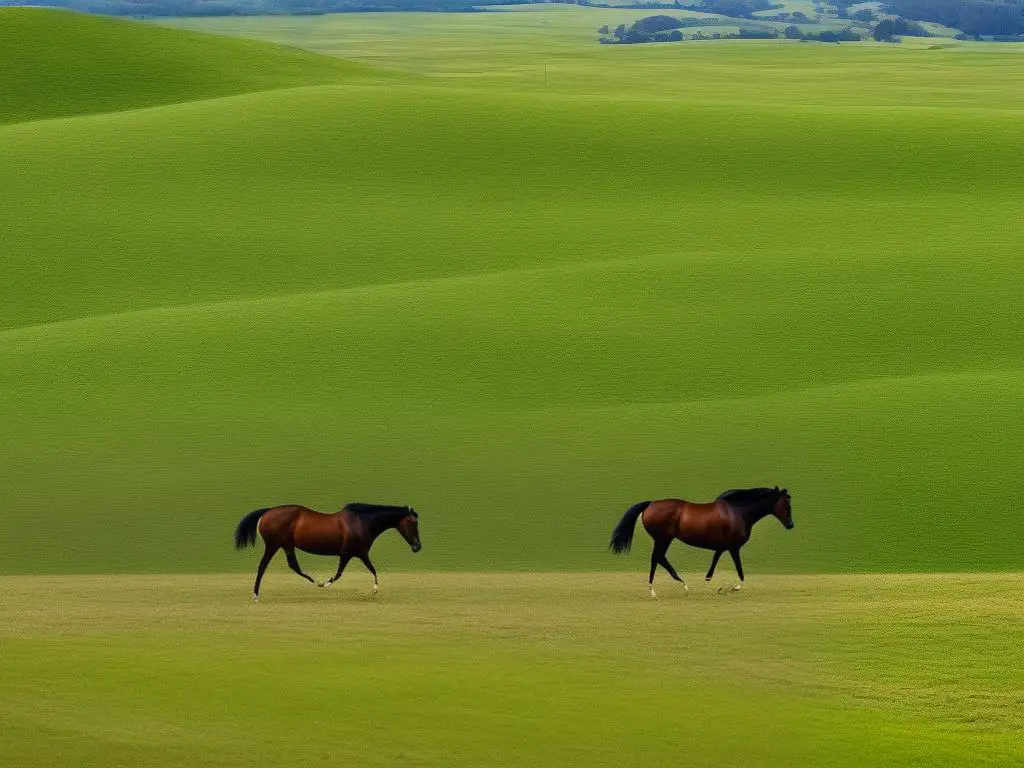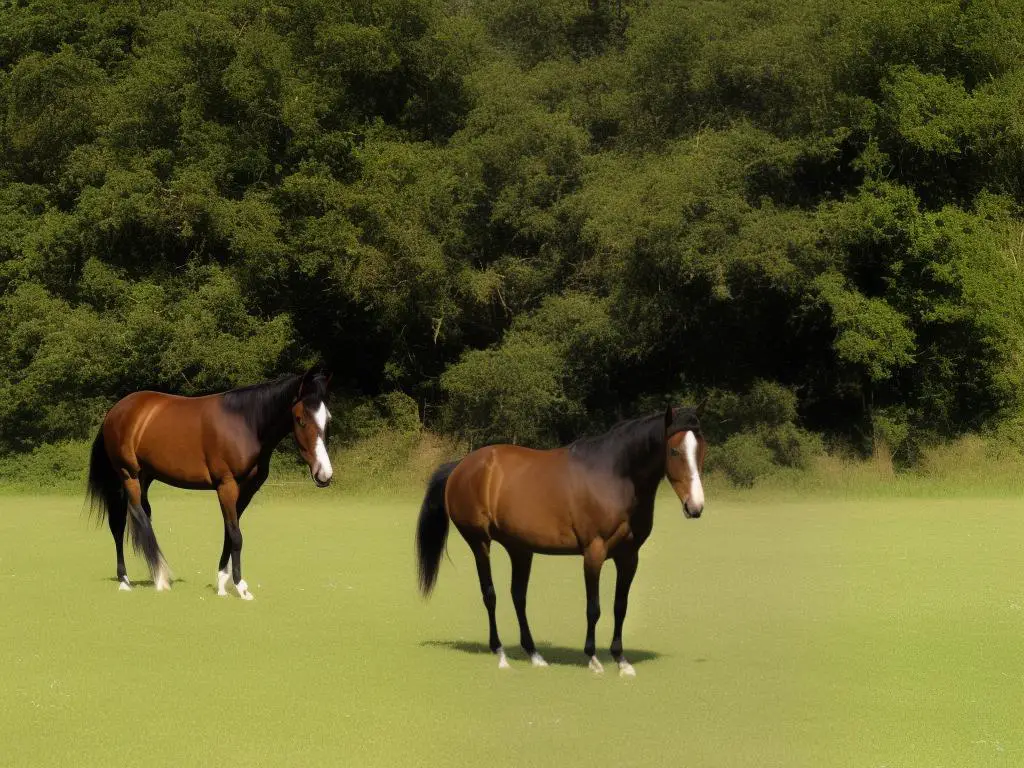In the captivating world of equine breeds, the Holsteiner horse stands out for its significant historical lineage, unique characteristics, and remarkable abilities in equestrian sports. Originating from Germany’s Schleswig-Holstein region, the Holsteiner, in its centuries-long journey, has evolved under the direct influence of historical elements, geographical factors, and strategic breeding efforts. This robust and versatile breed, with its documented history that dates back to the 13th century, exudes a fascinating tale of evolution and resilience that is as riveting as its impressive performance in various equestrian activities.
Table of Contents (Horspedia)
Origin and History of the Holsteiner Horse Breed
The Holsteiner Horse Breed
Originating from the Schleswig-Holstein region of Northern Germany, the Holsteiner horse breed boasts a rich and fascinating history. Known to be one of the oldest warmblood breeds, the Holsteiner’s ancestry can be traced back to the 13th century. The exact origin, however, remains unclear due to the lack of early written records. Nevertheless, researchers and historians believe that the breed originated from wild marsh horses that had been nearly extinct in the wild during the Middle Ages. These equines were instrumental for construction, farm work, and as transportation horses due to their strength and resilience.
Historical Evolution
In the 16th and 17th centuries, the breed underwent significant transformations. Spanish, Neapolitan, and Arabian horses, brought home by returning Crusaders, contributed significantly to the breed’s evolution. These horses, known for their agility and elegance, introduced refinement to the sturdy Holsteiner breed. By the 18th century, further improvements to the breed were made possible through the arrival of English Thoroughbreds, enhancing their speed and stamina.
The local monks in the Schleswig-Holstein monasteries, notably the Uetersen Monastery, played an important role in the breed’s development. They initiated a systematic breeding program focusing on traits like strength, fertility, and endurance in harsh climate conditions. By the end of the 19th century, the breed was well-known across Europe for its incredible strength, lightness, and agility.
Influence of Geographical Location
The Schleswig-Holstein region provided a breeding environment that significantly shaped the Holsteiner horses’ traits. The region’s marshy and damp area influenced the breed’s characteristics, namely, their strong hindquarters and powerful hocks. These traits developed over generations, helping the horses to navigate through the region’s soft, uneven ground – a feature that now is admired in show jumping and dressage.
Impact of Wars and Social Changes
The World Wars greatly impacted the breed’s development, mainly due to a severe decline in numbers and genetic diversity. During the World War I and II, the Holsteiner breed was on the brink of extinction and the breeding began to focus on producing working farm horses rather than sport horses, due to the immense demand in farming.
The post-war period saw a shift from utilizing horses for labor to using them for sport. Consequently, Holsteiners adapted once again and started selecting stallions with jumping ability and movement quality. Today, they are renowned for their aptitude in equestrian sports, mainly in dressage, eventing, and showjumping.
A Current Overview of the Holsteiner Breed
The Holsteiner horse breed is presently thriving and advancing owing to the diligent efforts of breeders worldwide. These animals are acclaimed for their adaptability, stamina, durability, and elegance, making them highly prized as elite equine athletes. They have effectively overcome historical hurdles, continually displaying resilience which is a characteristic of their breed’s fierce survival instinct. Today, the Holsteiner breed stands as a testament to successful breeding adaptations and progressive development over the centuries.

Characteristics and Qualities of the Holsteiner Horse Breed
The Distinctive Physical Characteristics of Holsteiner Horses
The Holsteiner horse breed, native to Germany, is revered for its unique amalgamation of power, agility, and aesthetic appeal, which contributes significantly to its global popularity. This breed is distinguished by a medley of physical traits and dispositions that makes them perfectly suited for a variety of equestrian pursuits.
Most commonly, Holsteiner horses are medium-sized, compact, with a sturdy physique, typically standing between 16 and 17 hands tall at the shoulder. This height gives them an imposing physical stature. Coat colors range from dark hues like black, brown, and bay to gray. A noteworthy feature of these horses is their powerfully built hindquarters, which enhances their athletic abilities. Their heads are finely chiseled, and their large, wise eyes open a window to their sharp awareness.
The Temperament of Holsteiner Horses
Besides their physical attributes, Holsteiners are admired for their temperament. They are known for being calm, intelligent, and willing. These kind horses display a unique eagerness to please, making them easy to train. However, they also have an inherent sense of self-preservation, which means they will not put themselves into dangerous situations. This makes them a trustworthy and reliable option for riders of all levels.
Versatility and Athletism
Perhaps the most recognized quality of the Holsteiner horse breed is its versatility and athleticism. They are incredibly agile and possess phenomenal jumping ability, thanks to their strong back and powerful hindquarters. Holsteiners are well-regarded in the equestrian world, often excelling in show jumping, dressage, and eventing. Some Holsteiners have even participated in the Olympics, further underlining their athletic prowess and adaptability.
Health Issues and Life Expectancy
In terms of life expectancy, Holsteiner horses typically live for 20 to 30 years. They are generally a healthy breed but, like any other breed, they may be prone to some specific health issues. Any potential owner should watch out for these common ailments, which include back problems, leg issues, and digestive disorders. Regular veterinary check-ups, a balanced diet, and routine exercise can contribute to a Holsteiner’s longevity and overall health.
Conclusion
Holsteiner horses are a prestigious breed, valued for their elegance, robustness, and adaptability. Their blend of sturdy physicality, acumen, and docility makes them multifaceted performers in diverse equestrian spectrums. Despite potential health challenges, with appropriate care and leadership, these stunning horses can lead lengthy, robust lives whilst yielding impressive accomplishments in the horse world.

The Holsteiner Horse Breed in the Equestrian World
Origin of the Holsteiner Breed
Born in Germany, the Holsteiner horse breed is acclaimed globally for its extraordinary skills in multitudinous horse-riding pursuits. Equally recognized for its nimbleness and might, the Holsteiner exudes a gentle demeanor, manifesting as one of the most desirable breeds for equestrian games.
Historical Significance of the Holsteiner Breed
Tracing back to the 13th century, the Holsteiner is said to be among the oldest of warmblood breeds. Initially bred by monks, these horses were designed to be resilient and powerful enough to work in the harsh agricultural lands of northern Germany. Over time, the breed’s impressive traits were honed for riding and equestrian sports, and the Holsteiners quickly gained fame on the world stage.
Holsteiners in Show Jumping
The Holsteiner breed, recognized for its athleticism, strength, and eager attitude, excels in show jumping arenas. Its bounding stride, coupled with its knack for accuracy and speed, makes it a staple at the Grand Prix level in international jumping competitions. Numerous top show jumpers, including the legendary Casall ASK, are well-regarded as Holsteiners.
Holsteiners in Dressage
Aside from show jumping, the discipline of dressage is another arena where Holsteiners often shine. Their fineness, combined with their natural understanding of intricate movements, has helped them succeed at the highest tiers of dressage. The breed’s grace, poise, and flexibility allow riders to exhibit control and harmony, essential traits in dressage competitions.
Holsteiners in Eventing
Furthermore, Holsteiners demonstrate exceptional versatility in eventing, which combines the disciplines of dressage, cross-country, and show jumping. Their endurance, speed, agility, and responsiveness contribute significantly to achievements in this absolute test of an equine athlete’s skill set. The breed’s braveness and boldness allow it to confront any type of obstacle with eagerness, which is crucial for cross-country courses.
The Breed’s Contribution to the Equestrian Sport
Given their profound influence and consistent high performance, Holsteiners have contributed significantly to the equestrian world. Their DNA has been integrated into the breeding programs of various other horse breeds to enhance certain traits. The global equestrian sports community values Holsteiners not only for their physical abilities, but also for their incredible intelligence and training receptivity.
The Outstanding Role of Holsteiners in Equestrian Activities
Holsteiners have played a transformative role in setting new standards of excellence in the equestrian sporting world. Their adaptability, performance drive, and innate abilities have left a lasting impression on both horse lovers and professionals. Given these characteristics, the Holsteiner breed is poised to continue flourishing in equestrian endeavors, enabling fresh milestones and accomplishments in the field.

Breeding and Preservation Efforts for the Holsteiner Horse
The Origin and Development of the Breed
Hailing from Germany’s Schleswig-Holstein region, the Holsteiner is among the most highly valued warmblood breeds. Valued for their resilience, athleticism, and wide-ranging abilities, these horses have proven their worth especially in areas like horseback riding, showjumping, and dressage. Such significance and widespread acclaim have led to substantial efforts towards breeding and preserving the Holsteiner breed for future generations.
Breeding Practices
Breeding practices for Holsteiner horses are quite stringent and selective to ensure that the breed retains its distinct characteristics. The Holsteiner Verband, the official body for Holsteiner horse breeding in Germany, meticulously approves and tests stallions and mares to ensure that only the finest Holsteiners are produced. To pass the selection process, horses are evaluated based on their conformation, movement, jumping ability, and pedigree. Only those with the greatest potential to add value to the breed are included in the breeding program.
In recent years, the international range of breeding has broadened to include mares and stallions from other warmblood breeds, leading to genes exchange from other warmbloods into the Holsteiner breed. However, care has been taken to select only the best and suitably matched horses to maintain the quality and integrity of the breed.
Notable Breeding Operations
Many reputable establishments are involved in the production and preservation of Holsteiner horses worldwide. Some of the most notable ones include Germany’s Holsteiner Verband, the American Holsteiner Horse Association in the United States, and the Canadian Warmblood Horse Breeders Association in Canada. These organizations not only regulate breeding but also hold competitions and events to promote the breed and provide platforms for showcasing the quality of Holsteiner horses.
Regulations for Preserving the Breed
Regulations for preserving the Holsteiner horses extend far and wide. They typically involve tough selection parameters for breeding-stock approval, proper health check-ups, and breeding controls. The breeders must follow specific guidelines that are aimed at preserving the traits and characteristics that define the breed. These include an overemphasis on athletic ability, versatility, temperament, and physical conformation.
In some regions, particularly Germany, regulations have been established to limit the number of horses a stallion can sire each year to control the population and limit inbreeding. These regulations are overseen by reputable breeding associations to ensure the ongoing preservation of the breed.
Genetic Diversity and Health Issues
While Holsteiner horses are generally healthy and robust due to careful and selective breeding practices, concerns about genetic diversity have arisen. Given such intensive selection and control procedures, the Holsteiner breed has a relatively small genetic pool, increasing the risk of propagation of genetic health issues. To combat this, the inclusion of other warmblood breeds in breeding programs has been accepted under strict guidelines.
This practice not only broadens the genetic pool but also infuses fresh vitality into the breed. Consequences of lack of genetic diversity include inbreeding depression, which can impact fertility, immunity, and overall health. To mitigate these issues, regular genetic testing has been implemented for breeding horses to detect any potential genetic problems early on.
Conclusion
Breeding and preserving the Holsteiner breed is a rigorous and vital process that aims to nurture the distinguished traits of this horse breed while ensuring its continued existence. It involves a fine balance between maintaining the breed’s unique attributes and encouraging diversity to prevent genetic issues. This harmonious blend of preservation and progression allows the Holsteiner breed to remain a favorite among horse lovers globally.

The Holsteiner breed, woven into the fabric of equestrian culture, continues to enchant enthusiasts and experts with its strength, agility, and composure. As we reflect on the unbroken lineage, responsible breeding practices, and the breed’s striking presence in competitive spheres, the value and significance of this noble horse becomes immeasurable. Undeniably, the Holsteiner horse breed not only represents an exceptional amalgamation of history, performance, and preservation efforts but also personifies the inherent grace, power, and spirit of the equine world.
